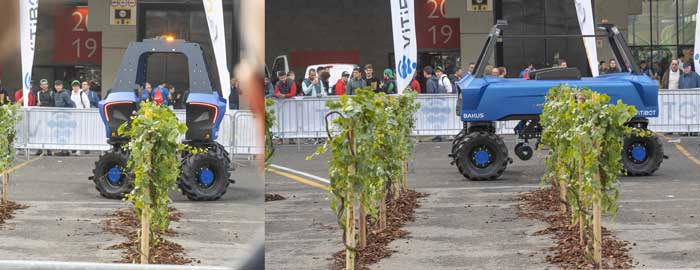Ag-focused Digital Innovation Hubs are just one way Europe is positioning to become a center of agricultural robotic technology. European Union funded projects, such as agROBOfood — a robust consortium of research entities and businesses — are creating collaborative spaces and providing capital to help technology developers apply robotics to the unique challenges of automating agriculture. Some results of those efforts were on display in a special exhibition of agricultural robots at the world exhibition of agricultural machinery EIMA in Bologna, Italy, in November.
Robotic “platforms” were among the displayed robots. These are essentially rovers or robotic tractors that provide the movement, navigation and power to operate various implements.
“The machines are general. You just have to design a new piece [attachment] for specific applications,” says Alessio Bolognesi, Italian Agricultural Machinery Manufacturers Federation FederUnacoma digital agricultural technical officer.
Italian company Field Robotics offered a medium-sized modular full-electric platform with plug and play elements such as a mulcher and sprayer for use in vineyards. They’re next working on a robotic arm for picking and a reduced dispersion sprayer. Recent advancements for their rover have been in navigation and power.

Demonstration of a vineyard-specific weeding robot.
The rover is guided by Lidar, GPS and 4 cameras. The Field Robotics platform has been in testing and development in fields for 5 years. This extensive development is critical due to the complex nature of autonomous agricultural navigation.
“The environment is always changing in a vineyard. In spring there are no leaves, then leaves are constantly growing and green then they turn red,” says Massimiliano Ruggeri, robotics researcher and agROBOfood project manager. “You use machine learning to learn to navigate the environment. Then you test the machine, prove it knows what it’s doing and that it’s safe and then you have to block the artificial intelligence. If you don’t block the AI, the machine keeps learning. It may evolve in an undesirable way.”
Initially a product of several University of Bologna engineering and control systems research groups, the Field Robotics rover is fully powered by renewable energies and can work continuously in the field for the entire season. When the battery is depleted, the rover autonomously returns to the solar-powered docking station to recharge. The idea is no fuel, no plug, no maintenance, just leave it to work all season.
Also on display was the Moondino rice patty robot made by Swiss company ECO Process and Solutions. It earned an EIMA Technical Innovation Award for its power solution. The robot autonomously prowls rice paddies weeding dry and submerged soils powered by an onboard solar panel. This setup allows it to work continuously for up to 2 months following maps created during rice sowing.

Alessio Bolognesi
“Power density and the amount of power a cell can provide are the main challenges for [the development of] large electric tractors. That’s not the case for robots. Robots are generally smaller machines with low power consumption,” says Bolognesi, which makes fully electric power a possibility and a benefit. “We can make electric actions be very precise. Reaction time is down to a few milliseconds which is much more efficient and better for safety.”
The most promising tasks for robotics in agriculture are in specialty agriculture, says Ruggeri. In a robotics presentation at EIMA he said robots and co-bots in agriculture will first tackle agricultural tasks that require a high level of human involvement, tasks too strenuous for humans such as moving heavy objects or mechanical weeding, and tasks impossible for humans like spot spraying. The greatest potential lies in tasks where the unit cost is very high, such as with strawberry production.
“Farmers say they can’t find workers, or experienced workers. A robot can be the solution. They can work faster, longer and more precisely,” he says. However, creating an agricultural robot is complicated. “You need a lot of competencies working together. There needs to be artificial intelligence, mechanical, electrical, batteries and agronomics. It’s hard to find all those competencies in one company.”
The agROBOfood project serves to gather specialists and innovators in those various competencies through a network of digital innovation hubs spread throughout Europe. The project identifies companies with projects with potential and incubates them. They provide funding, testing, space to develop and opportunities for collaboration.
A still significant hurdle for agricultural robotics development and adoption is the farmer.
“It’s still quite difficult to gather interest from the farmers. There is a lot of curiosity, but there’s no evidence of the benefits. There are no case studies to say if you invest a certain amount of money, you’re going to get it back in a certain amount of time,” Bolognesi says. “We must light up some minds to start investigating and try the machines. We need to create situations where farmers [see] robots working in the field. Touch the machines. Understand that they’re simple to use compared to a tractor. They’re like I-phones. You just set some parameters and the machine is set to go.”






